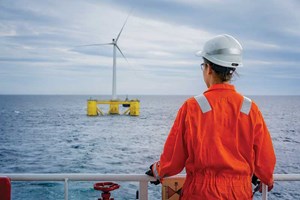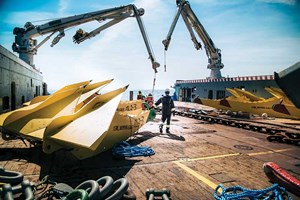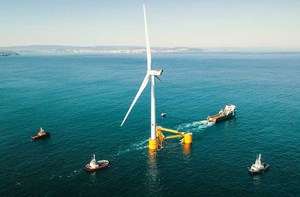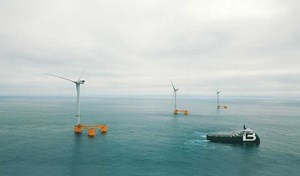The rise of floating offshore wind energy
Maximizing the energy that can be harnessed from the wind often means locating floating offshore wind facilities in extremely inhospitable waters. They are positioned where the winds are at their strongest and most constant. The ferocity of the swell created by wind gusts can be a challenge to be overcome throughout the project, from towing the unit into place, then installing and maintaining the facility, and eventual decommissioning. Overcoming the daunting metocean challenges requires the combined engineering and construction expertise of multiple companies, to ensure flawless project execution and efficient expenditure of capital resources.
WINDFLOAT ATLANTIC
Battling against severe winds and a challenging swell in the Atlantic Ocean, teams from Bourbon Subsea Services worked alongside Principle Power, designer of the floating foundations, and Vryhof, supplier of the mooring system, to complete the installation of the WindFloat Atlantic project, a three-unit offshore floating wind farm. The project, which was launched in 2019, is sited approximately 20 km off the coast of northern Portugal, 75 km north of Porto.

The powerful WindFloat Atlantic project consists of three 8.4 MW Vestas wind turbines, the largest installed to date on floating platforms. The towers are 100 meters (m) tall and the diameter of the rotor assemblies is 164 m, Fig. 1. The average water depth of the site chosen for the installation is 100 m. The floaters are 30 m tall, with columns 50 m apart.
Our first involvement in the project consisted in procuring and pre-laying the mooring systems for all three units. Bourbon was responsible for reviewing and approving the design documentation, overseeing manufacturing and testing, and ensuring certification by ABS. The company then deployed and embedded the nine lines (three for each floater) at the future site of the wind farm. This operation, which involved anchors, chains, and a variety of sections and accessories, took a few weeks in May and June 2019, Fig. 2. It required a large anchor handling and tug supply (AHTS) vessel with powerful bollard pull. The mooring lines were then left on the seabed until the arrival of the floaters.
The wind turbines for WindFloat Atlantic were assembled and mounted on the floaters at the quayside in the port of Ferrol, northwestern Spain, minimizing offshore time by comparison with the assembly of conventional fixed-bottom wind turbines, which has to be carried out at sea. In October and December 2019 and May 2020, our vessels towed the units from Ferrol to the site of the wind farm, off Viana do Castelo, a transit distance of approximately 155 nautical miles, taking around three days of sailing.

On arrival at the destination, each floater was hooked up to three pre-laid mooring lines. This was followed by installation of the electric cables: the first of the three turbines was connected to a shore line, and then the second and third turbines were connected up in series by an inter-array cable, Fig. 3. All the hook-up operations were completed in less than a week, using marine spread that included an offshore tug, a harbor tug, a multi-purpose supply vessel, and a remotely operated underwater vehicle.
Because of the severity of the weather and swell conditions off the Iberian coast, it was necessary to find windows of six days in which the towing and installation could be completely achieved in safety for approximately 70 Bourbon Subsea Services personnel on the various vessels, as well as for the client team. Confidence in weather forecasts over the winter period in the North Atlantic is only about a few days, so even when the go-ahead came to begin towing from Ferrol, there was no certainty as to how conditions would be at the destination.
The Covid-19 pandemic also proved problematic: the third mission was delayed by several weeks of lockdown. When it eventually could be carried out in May/June 2020, additional complications arose from the procedures and protocols that had to be introduced into an already complex operations schedule, because of differing Covid-19 regulations in different countries (Portugal, Spain and France). Compulsory quarantine periods and Covid-19 tests were imposed on all personnel.

Eventually, all operations were completed successfully. The first of the three wind turbines was connected to the Portuguese national grid on Dec. 31, 2019, when the first electricity was generated and injected into the grid. According to the schedule, the third and final turbine was fully operational by the end of July 2020, with 25 MW of power coming to shore, Fig. 4.
COLLABORATIVE EFFORT
The WindFloat Atlantic project was developed by the Windplus consortium, formed by three leading European energy producers, EDP Renewables and Repsol from Spain and ENGIE from France, along with Principle Power, designer of an innovative floating foundation for wind turbines.
The prototype version of this semi-submersible floating foundation was known as WindFloat 1 (WF1), a single floating structure that was anchored by Bourbon 5 km off the Portuguese coast, near Aguçadoura, roughly 40 km north of Porto, and was commissioned in 2011. The 2-MW-capacity turbine successfully generated 17 GWh of energy over a five-year period, until it was decommissioned in 2016, having proved itself capable of producing a reliable supply of power while enduring harsh Atlantic Ocean conditions, with waves of 17 m and wind speeds rising to 60 knots and more.

Back in 2011, Bourbon Subsea Services was already responsible for deploying and tensioning the mooring lines, towing the floater, and performing the hook-up, as well as connecting the dynamic power cable to the export cable. We had taken on a project management role and carried out detailed engineering.
The success of the single-unit prototype soon led to the next step: the development of a multi-unit project. The Windplus partners started planning WindFloat Atlantic as a three-turbine wind farm that would use wind turbines with much higher capacity. The three MHI Vestas V164 turbines to be installed on individual WindFloat platforms would each generate 8.4 MW, making them the most powerful wind turbines used to date in floating offshore wind farms. This would make a total capacity for the array of approximately 25 MW, more than ten times the capacity of the initial single-mast prototype of 2011 and enough energy to provide power for roughly 60,000 users.
Engineering studies for WindFloat Atlantic were completed in late 2018. The Windplus consortium awarded a turnkey contract for the mooring procurement and installation to Bourbon Subsea Services, a subsidiary of Bourbon, in October 2018. Having taken part in the WF1 prototype project, we had subsequently gained additional experience in the floating offshore sector through our involvement in the Floatgen project off the Brittany coast, followed by the Kincardine project in Scotland, where we again worked alongside Principle Power, which designed the semi-submersible floating foundations.
The Bourbon Subsea Services contract included project management, engineering, and procurement of the mooring system, as well as on-site campaigns: in the first place, receipt of the mooring equipment and installation of the mooring lines, and then secondly, towing each floater from the port of Ferrol, Spain, where it has been assembled, hooking it up to the pre-installed mooring lines and finally installing and connecting the inter-array cables.
WHY FLOATING WIND TURBINES?
The headline target of the Paris Agreement on climate change restricts further global warming to a maximum of 2° C, ideally 1.5° C, through an energy transition that will see the adoption of low-carbon and no-carbon energy technologies. To achieve this, few solutions currently on the drawing board can match the potential of wind energy. Not all parts of the world enjoy enough sustained sunshine to make solar energy cost-effective, or are close to the fast-flowing water courses that can make hydro-electricity a realistic proposition. Wind, though, is available to all: although it is at relatively low levels in some geographic settings, it is an ever-present powerful force of nature in many others, ready to be harnessed and to play a key part in fighting the climate emergency.
However, there is no unanimity on the desirability of large-scale onshore wind farm development. Many parties highlight such advantages as relatively rapid and cheap installation and easily accessible power, for instance, yet there are pressure groups opposing almost every new project on esthetic grounds: some may find terms like “eyesore” to be unjustified, but there is no doubt that they do radically transform the landscape.
The introduction of offshore wind farms to the range of renewable energy options dates back to the Vindeby project in Denmark in 1991, with 11 turbines generating just 5 MW of electricity, but the technical and physical obstacles that had to be overcome before the technology could be made cost-effective were such that it was only in the early years of this century when a number of offshore wind projects around the world began to make a significant impact.
There were benefits to offshore wind farms. Wind resources at sea tend to be more abundant and more stable than on land—the winds are stronger, because they are not disrupted by land masses. In many parts of the world, the population density is greater in coastal regions, so offshore wind farms can be sited where they can conveniently satisfy energy needs. Furthermore, a cluster of wind turbines is less visually obtrusive at sea than on land, tending to reduce the likelihood of objections from local residents.
Other factors militated against offshore wind farm projects, however. As technology developments led the way, not only to increasingly large wind turbines with taller towers and longer rotor blades, but also to a much greater number of units in a single wind farm made possible by higher capacity substations, the issue of visibility from the shore became more problematic. Wind farms became less discreet. Although not marring picturesque vistas of rolling hillsides, densely packed groupings of white windmills on the horizon were still often seen as blots on otherwise uninterrupted seascapes.
Installing wind farms farther out to sea was a solution. This option would mean that they were less visible from land, perhaps barely visible at all. They would also interfere less with coastal shipping routes. There would be the added bonus that winds are stronger and more sustained further from land. The main added complication, though, was critical: in far deeper waters, solid foundations piled into the seabed are not feasible (at least from the economic point of view). To solve the issue of deeper water, the future wind turbines would have to be installed on floaters.
Taking inspiration from the floater systems that have been developed for floating oil platforms, Principle Power and other companies launched design projects to engineer systems that would be capable of supporting a wind turbine in persistently windy conditions, resisting heavy swell. Several solutions have been designed and developed. The semi-submersible floater chosen for the WindFloat 1 prototype in 2011 was a three-legged triangular configuration built for a 2-MW wind turbine. Subsequently, Principle Power designed it on a larger scale for the Windplus consortium to use for WindFloat Atlantic’s larger wind turbines. Other floater systems exist, such as the spar buoy, a system based on a single cylinder, and the tension leg platform, which requires deep port proximity for assembly.
Two offshore wind sectors. The development of these floating systems has led to the offshore wind sector being subdivided into two sectors, generally known as “fixed-bottom offshore,” with support structures installed on the seabed and depths of up to 40 to 50 m, and “floating offshore,” with greater depth capabilities. At present, there is no comparison between the two in terms of scale—according to figures published earlier this year by the United States National Renewable Energy Laboratory, the global installed capacity for fixed-bottom wind turbines stands at 27,208 MW, while that for floating wind turbines is currently a mere 82 MW.
Around the world, there are still only ten floating projects in the water. However, bearing in mind that an estimated 80% of the world’s offshore wind resources are at depths of 60 m or more, the industry’s expectations are that development of the floating sector will accelerate over the next two or three years, and achieve a level of full commercialization by 2024.
PRE-COMMERCIAL PROJECTS
In the space of a few short years, the floating offshore sector has moved from proof-of-concept projects and prototype developments to the current crop of projects that are termed pre-commercial or demonstration projects. These are fully operational, although small-scale, wind farms consisting of three to five units, with the main priority of demonstrating economic feasibility, as well as trialing and validating logistical options and installation methods, although not necessarily in the most cost-effective fashion. They are still dependent on government subsidies.
But the industry is on the cusp of seeing an extraordinarily rapid ramp-up in the scale of new projects. The next round of floating offshore projects to reach the call for tenders stage are likely to be on an industrialized scale. The wind farms will comprise not three or five floating wind turbines, but probably eight to ten (Erebus Wales project with Total in the UK) to 25 units (two French projects to be commissioned between 2025 and 2030) and then an even larger scale (the Scotwind leasing round, for instance, with projects be commissioned between 2025 and 2030 in Scotland).
Economics of fixed bottom versus floating turbines. It is estimated that the cost of electricity from a demonstration project, such as WindFloat Atlantic, is three times greater than the cost will be when the projects of the near future are operational. Industrialized construction and installation processes, in addition to numerous economies of scale, will lead to an increasingly profitable and efficient method of harnessing natural energy. It will become still more profitable when technological advances allow even larger and higher-capacity wind turbines, probably by 2030, allowing an equivalent amount of power to be generated by fewer wind turbines and floaters, meaning less capital investment and lower installation costs. By this time, the cost of electricity from fixed-bottom and floating turbines will most likely be comparable.
PATH FORWARD
For the manufacturers of the turbines, the fabricators of the floaters and the maritime companies responsible for towing, mooring, installing, and hook-up services, the challenge that lies just around the corner will be managing such a spectacular ramping-up in the scale of operations.
Bourbon Subsea Services has the necessary manpower and assets available to keep pace with such a step-change. Projects on a much larger scale will not require the availability of many more vessels; they will require the availability of the same vessels over a longer timeframe. Seasonality will be a challenge, however: in the hostile marine environments selected for floating wind farms, depending on regions, there will generally be a window of only about six to eight months in the year when towing and hook-up operations can be performed safely. However, it would be possible for the pre-laying of the mooring lines to be carried out during the winter months.
Having amassed vast expertise and established its reputation as a top-ranking service provider in the oil and gas sector, Bourbon is now able to leverage all its experience and know-how in the high-potential sector of offshore floating wind farms. At a time when numerous oil and gas majors are repositioning themselves as energy companies with significant interest in renewable projects, we are positioned to continue to be a skilled and experienced maritime partner for them in this new sector, with marine resources available throughout the world.
To better understand the installation process of a floating windfarm and experience the human adventure behind the WindFloat Atlantic project, watch a series of videos:
www.floatingwindinstallation.com
BOURBON AND ITS PARTNERS
In 2019, Bourbon operated a fleet of 458 vessels and had over 8,200 skilled employees in 44 countries. It is among the market leaders in surface and sub-surface marine services for offshore oil and gas. Since 2011, its Subsea Services division has acquired unique experience in offshore wind turbine installation. After installing the first wind turbine in Portugal, it then installed the anchorage of the first floating wind turbine in France as part of the European Floatgen project in 2017 and the Kincardine site off Aberdeen, Scotland, for the Spanish construction group Cobra. Bourbon Subsea Services is the European leader in offshore wind turbine installation.
Vryhof provides innovative and customer-focused anchoring and mooring solutions to many of the offshore oil and gas industry’s leading companies. In recent years, with its installation partners, Vryhof has been active in the offshore renewables sector, offering innovative and cost-effective permanent mooring solutions, including design, procurement, installation, life extension, and decommissioning. Vryhof is backed by HitecVision, the leading European private equity investor in the offshore energy industry.
Principle Power is a global energy technology and services company. Its proven WindFloat floating technology has unlocked offshore wind potential worldwide by enabling projects to harvest the best wind resources, irrespective of water depth or seabed condition. A trusted partner to developers, independent power producers, utilities, and EPCs, Principle Power is the market leader in floating offshore wind technology, with over 100 MW under construction.
- Advancing offshore decarbonization through electrification of FPSOs (March 2024)
- Subsea technology- Corrosion monitoring: From failure to success (February 2024)
- Driving MPD adoption with performance-enhancing technologies (January 2024)
- Digital transformation: A breakthrough year for digitalization in the offshore sector (January 2024)
- Offshore technology: Platform design: Is the next generation of offshore platforms changing offshore energy? (December 2023)
- 2024: A policy crossroads for American offshore energy (December 2023)


